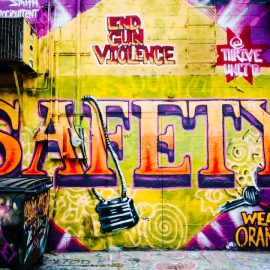
Why are women being silenced in society? What prominent figures have silenced their victims in the past?
The authoritarian belief that men have the right to control women is what motivates misogyny and the mistreatment of women. According to Rebecca Solnit, mistreatment and control include silencing women’s voices.
Continue reading to learn the many ways men have used their privilege to shut women down.
Women’s Voices: Silence and Credibility
What are some ways men are silencing women? One way is when a man talks over a woman to “mansplain” something to her that she already knows, he asserts that his own voice is more important and authoritative than hers—he is silencing her because he automatically assumes that she has nothing of value to say.
Violence is also a way to silence women. When someone reacts violently to a woman expressing her opinion or asserting her autonomy, it’s an attack on her right to take up space and to participate in the world—which are supposed to be basic human rights granted to everyone. Solnit suggests that denying women these rights reduces them to the status of subhuman beings.
(Shortform note: Experts suggest that speaking out against the patriarchy doesn’t only cause discomfort for men—both those who consciously believe they should have control over women and those who don’t share this belief but benefit from the privilege it affords. It also causes discomfort for anyone who has internalized sexism and misogyny. For example, a social media post from a woman calling out an instance of misogyny may receive more backlash than a selfie in a pretty dress would. This discomfort and backlash—potentially even from other women—makes it difficult for anyone to speak up about the mistreatment of women regardless of their gender.)
Silencing Victims: Three Stages
Solnit explains that women are often expected to remain silent after experiencing violence—both so the perpetrator can avoid accountability for their actions, and to reinforce the status quo of gender inequality. There are many people involved in this silencing, including the media, the perpetrators, and society in general. Solnit describes three stages of silencing that victims have to overcome in order to make their voices heard.
Stage 1) Psychological and Social Barriers
According to Solnit, the first of these stages relates to existing barriers to women speaking out, and it’s largely internalized. Experiencing violence—particularly sexual violence—often results in strong feelings of shame, as well as confusing feelings like doubting oneself and repressing one’s experiences. There are also negative social consequences for speaking out, so women often fear being socially excluded for sharing what happened to them.
Stage 2) Punishment
The second stage, punishment, is external. Solnit explains that people often deliberately punish women who speak about their sexual assaults—shaming them, harassing them, and sometimes even assaulting or murdering them. Solnit notes that rape victims in high schools and colleges are particularly likely to be subjected to this type of silencing and that many rapists are allowed to graduate without ever being punished for their actions.
Stage 3) Discrediting
According to Solnit, the third stage of silencing—discrediting the woman and her story—occurs when stages 1 and 2 have failed to prevent a woman from speaking up. People who try to silence a woman in this way suggest that her story is a lie and portray her as unreliable and deceptive. They also victim-blame by suggesting that she deserved the violence because of her behavior. Additionally, they argue that, even if her story were true, it’s in the past and there’s no need to dredge it back up now.
Wielding Social and Political Power to Silence Victims
Solnit argues that since authoritarianism (including the authoritarian belief that motivates violence against women) is rooted in a stark power imbalance, men in positions of power can be particularly adept at silencing and discrediting women. As an example of this, she explains how Clarence Thomas was appointed to the US Supreme Court despite allegations of sexual harassment directed at him by his employee, Anita Hill. Hill was harshly interrogated by a room full of men who disbelieved her, and the media publicly smeared her.
The accusations didn’t prevent Thomas from rising to one of the most powerful positions in the nation. However, Solnit suggests that it marked a milestone in the feminist movement that caused the nation to take the (then relatively new) concept of workplace sexual harassment seriously.
Prominent media figures also have a disproportionate influence over the stories of people who accuse them of sexual violence. Solnit describes how filmmaker Woody Allen attacked the credibility of his adopted daughter, Dylan Farrow, after she accused him of molesting her. Allen claimed that Farrow was lying and being coached by her mother. Many people leapt to Allen’s defense and contributed to the discrediting and silencing of Farrow. According to Solnit, Allen’s supporters and detractors were largely split by gender, as women recognized and related to what Farrow said happened to her, while many men believed it was a false accusation.
False Rape Accusations
People who defend those accused of rape or sexual assault also silence women by frequently claiming that the accusations are false. Solnit explains that false accusations of rape do happen, and that they’re serious, but they’re a tiny fraction of total rape accusations. Furthermore, a report in 2000 from the US Department of Justice found that only 12% of reported rapes resulted in jail time for the offenders, making the likelihood of serving time for a false accusation extremely small.
(Shortform note: Research suggests that most people believe false rape accusations are much more common than they actually are. One poll found that almost half of women and more than half of men think false accusations are very common. Another study found that more than half of police officers surveyed said that between 10% and 50% of all people who report sexual assault are lying—and 10% of officers surveyed said 50% to 100% of such people are lying. While it’s difficult to determine the exact number of false accusations, research suggests that it’s between 2% and 8% of total rape accusations.)

———End of Preview———
Like what you just read? Read the rest of the world's best book summary and analysis of Rebecca Solnit's "Men Explain Things to Me" at Shortform.
Here's what you'll find in our full Men Explain Things to Me summary:
- How "mansplaining" comes from a cultural tendency to devalue women
- The attitude of control that motivates the mistreatment of women
- The role that language plays in the advancement of women’s rights






